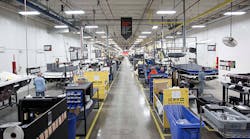Fog rolls over the Little Tennessee River and every little town that surrounds it. The hills are filled with the stuff, and it cuts visibility to a couple car lengths. Tough morning to drive the roads. Tougher morning to drive the water.
That last part might not sound like a problem, but it is, and it will remain a problem for MasterCraft Boat Company in Vonore, Tennessee, about 40 miles southwest of downtown Knoxville, until the last of it lifts. The company tests every one of the 16 or so boats it churns out every day out on that water, and if you can’t see, you can’t drive.
Not many manufacturers deal with that production challenge, but MasterCraft is not most manufacturers. The product, for starters, is far larger and much more a discretionary income purchase (most of its boats fall within $50,000 and $150,000). Its assembly line is incredibly labor-intensive, with human hands on it at almost every turn (with no plans for robots, since the return on investment would take almost a decade). And much of the leadership cut its teeth in other industries, coming over from automotive and aerospace, and applying best practices for a different culture.
MasterCraft Boat CompanyVonore, Tenn. Employees: 466, non-union Total Square Footage: 228,000, about 70% of it devoted to manufacturing Primary Product/Market: Wakeboard and ski boats Start-up Date: 1968 Achievements: After dropping to No. 2 in market share in 2012, the company has increased net sales and total boats sold every year; increased footprint capacity by 40%; reduced customer rejection rate by almost 48%; increased on-time delivery to customers to 96%; and returned to the top spot. |
“We come in,” said COO Shane Chittum, who moved from a Tier 1 auto supplier in June 2011, “and we start applying all this philosophy and making massive changes. We just kind of went through that initial definition and deployment phase, and now we’re getting into that development phase.” The reaction from plant veterans was significant, but the new philosophy spread, and today is implemented in every corner of the company.
Chittum was the first of a wave of new senior management brought in after the worst of the recession, in part because of the failures and frustrations of that slower economic time, in part because of financial problems of previous ownership. Director of manufacturing Larry Janosek followed in January 2012, president and CEO Terry McNew in August 2012, and VP and CFO Tim Oxley in October 2012, with VP of global sales and marketing Jay Povlin climbing aboard in 2013.
The culture they have created together in less than an Olympiad is significant, with every detail accounted for, right down to the font selection for all signage and marketing, including business cards (a bold sans serif, in all caps). The lean process has produced the most noticeable change, though, with every one of the almost 500 employees tasked with submitting ideas for improvement, no matter how small. The average for the last year? More than 26 ideas per employee, with about 10% of them actually implemented somewhere on the floor.
“There are two things I know about human beings,” Chittum said. “One is they appreciate learning, because they’re adding value to their brain. The other is they love to add value and contribute. People want to be productive in this world. So if we can connect our lean leadership philosophy toward teaching them all the tools, how to understand lean, to understand what waste looks like, then we can teach them the tools to monitor and measure waste, and connect it to them actually executing it.”
As recently as five years ago, the company was “a three-man show,” Chittum said. “I’m encouraged to tell you that today people might have 20 people underneath them, or 40 or 50 people underneath them, and there is a lot of alignment.”
MasterCraft Boat Company
Plenty of challenges still remain, of course. Eastern Tennessee is to wake and ski boats what Detroit is to cars, with rival Malibu headquartered about 20 miles away, and SeaRay, Skier’s Choice and Yamaha jet boats all manufactured within the same radius, which creates an incredibly high turnover rate. The sheer cost of the boats, too, limits the potential audience and creates competition not in boating but in other splurge purchase areas, like motorcycles (like Harley-Davidson) and recreational utility vehicles (like Polaris).
“As you can imagine, nobody needs a $150,000 boat, so quality is one of the distinguishing factors,” Chittum said. “We have distinct appearance standards.” And a strict testing regimen. Good thing the fog lifted around noon. The water was 38 degrees, teeth-chattering for most, but just fine for the hull of a new boat still crafted by plenty of hands.




